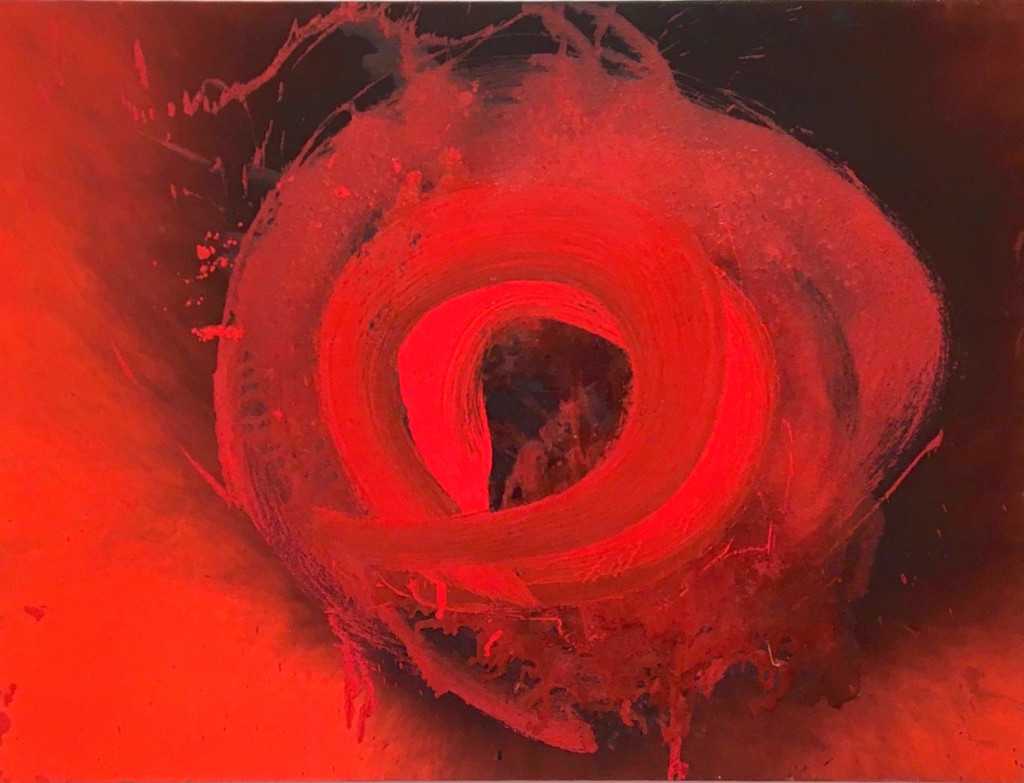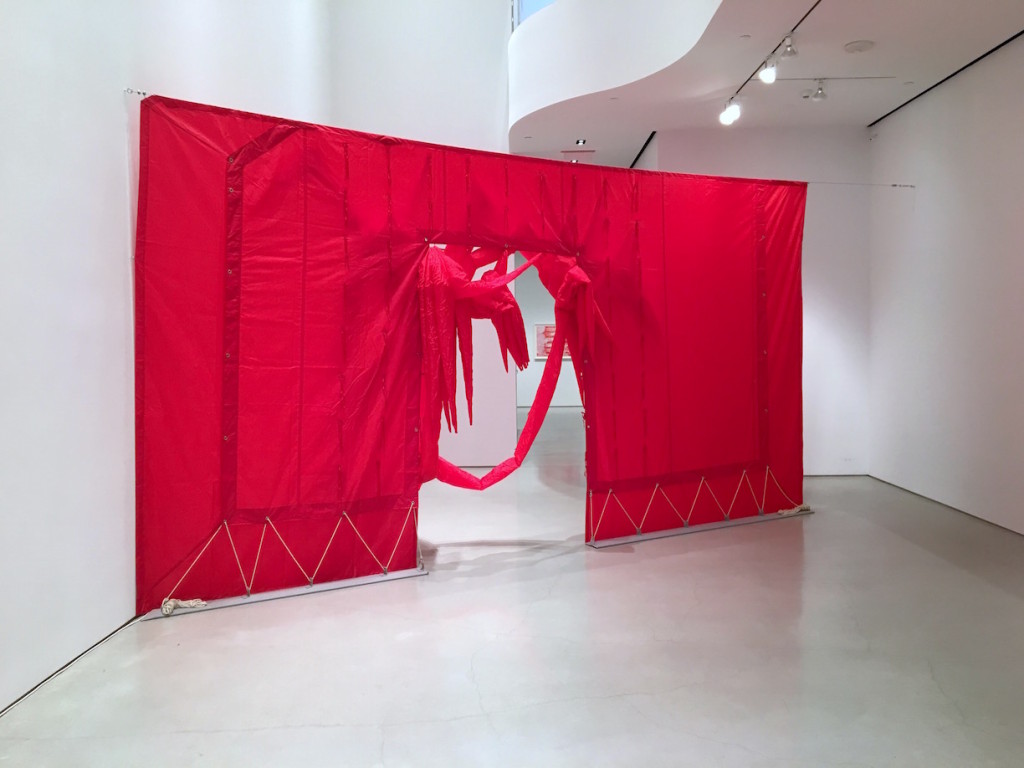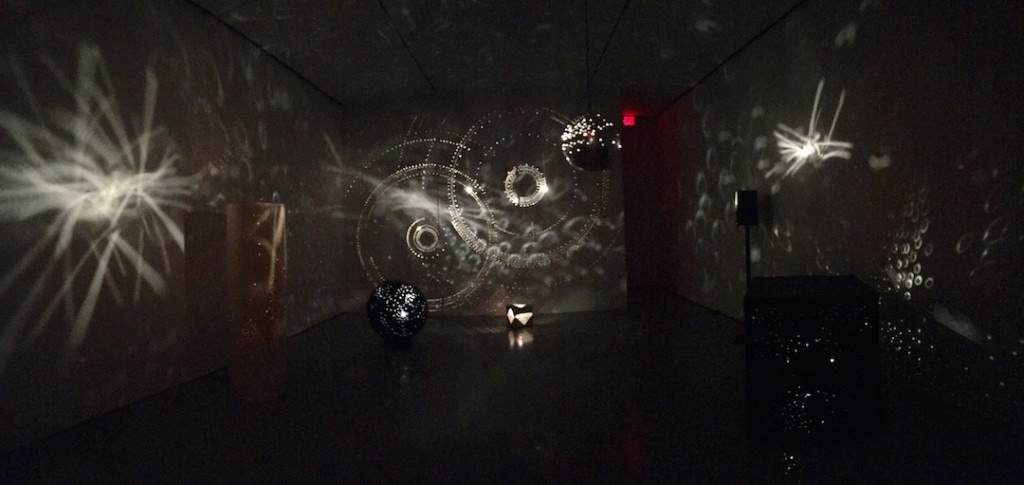
Otto Piene, “Cyclops” (1993-94), Oil and fire on canvas, Sperone Westwater, New York, Photograph by Jongho Lee, 2016
It is a seldom that an audience should walk out of a gallery with a feeling of completion, a complex understanding of the body of artworks in the space and how they converse with each other. After walking through Otto Piene (1928-2014), Sundew and Selected Works 1957–2014, at Sperone Westwater, it was possible to visualize not only some of the artist’s thought process, but also clearly see the dialogue between the works themselves.
The ground floor bursts with a vibrant red, and even from the hallway leading to the first room, one can see Red Sundew (1970) his inflatable sculpture made of silk and polyethylene inflated by electric fans, then deflated again periodically, mimicking the motions and the color of a fire. The paintings in this room are striking: all of them, with the exception of one, are black and red. The red looks as if Piene had magically used alchemy to make it appear more vibrant. In a way, he did exactly that through the utilizing fire as a medium in these paintings. It is remarkable to observe how he embodied the ferocious and unforgiving spirit of a fire through a paradoxical process of controlling it when making these paintings.
In the next room, Piene’s experimentation with material and with the interaction of a given material with a chosen surface whether it be board, paper, or one that he primed with clay, is apparent in every piece. More textural elements are at play in this room, especially in Goldregen and Platinsoldaten, both done in 2014, where he used gold and platinum glaze on clay, texturing the surface with little beads of gold and platinum. This room acts as a nice transition to the first section of the second floor, the colors of gold and platinum resound, where we see more of his experimentation with fire, this time mostly with gouache and paper.

Otto Piene, “Red Sundew 2”, (1970) Installation view, Sperone Westwater, NY, Photograph by Jongho Lee, 2016
The following room on the second floor, what the gallery calls it’s “moving room” sets the stage for the crux of the exhibition. This dimly lit room has just four pieces, which, on a surface-level, are unimpressive. Just before we enter, there is a sign: “ATTENTION: Otto Piene’s Lichtgrafik, made between 1959 and 1962 on light-sensitive paper, are exhibited in a low light setting in the next gallery.” Through all his experimentation with material shown in previous works, Piene, in these pieces, is trying to capture something else on a surface: light. At this stage of the process, it is unsuccessful. The paper is light-sensitive and needs to be maintained at a low light setting. It is hard to see the pieces due to a combination of dim lighting and the fuzzy content of the work, but these three pieces prove to be a conceptually crucial step for the development of his next works.
The journey through the gallery leads to this crucial moment. In a dark room are six sculptures, some of them cubes, some of them spheres, and a wall with holes that make the shape of two big circles overlapping each other, with a smaller circle within each one. The sculptures themselves have holes in them and a rotating light fixture inside, creating moving drawings on the walls of the gallery. It becomes impossible to tell which part of the light is coming from which sculpture, and at a certain point, it becomes impossible not to get lost in these drawings.

Otto Piene, Installation view, 3rd Floor Gallery, Sperone Westwater, NY, Photograph by Jongho Lee, 2016
The results are truly mesmerizing. Just as Piene captures the essence of fire with fire, he captured the essence of a material as ephemeral as light not by trying to capture it on a surface. The installation on the third floor shows a level of exploration that transcend the bottom two floors, especially when considering his efforts to capture certain properties of light through his Lichtgrafik series: although he had captured light on a surface in these series the same way he had captured fire or brass or platinum, the results were not as captivating. The decision to flesh these works out and execute them the way he did by using the whole room and its walls as his surface, Piene was not only able to capture the essence of a material as elusive as light, but ask bigger questions about something ephemeral, yet part of a larger life cycle than the one we as viewers are used to thinking about.
